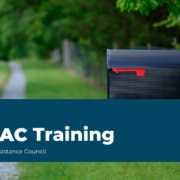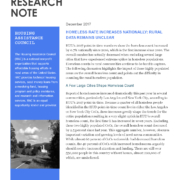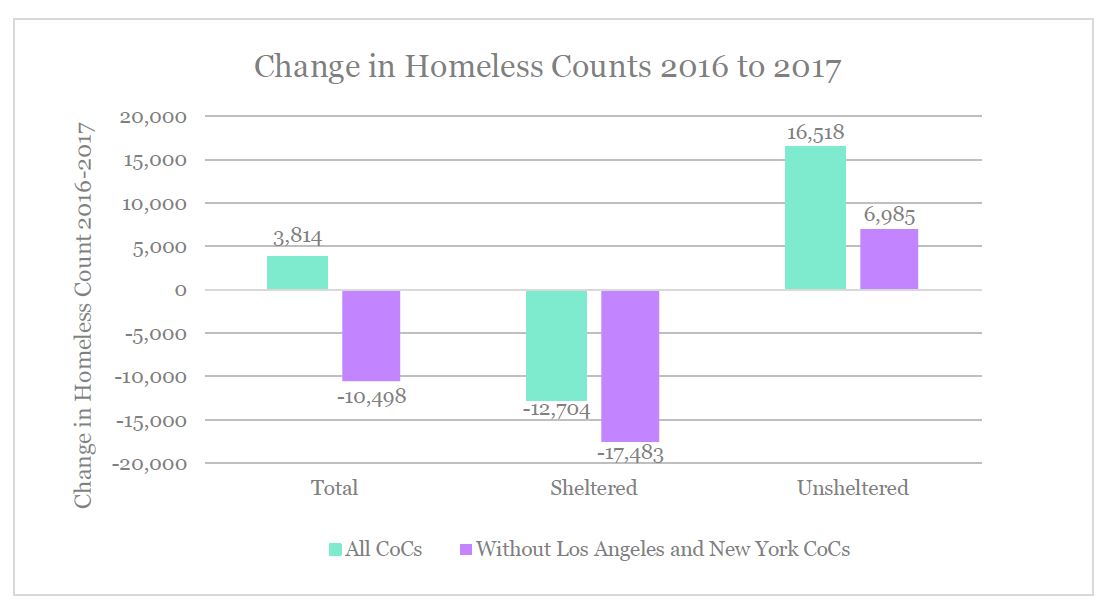Webinar recording and slides posted
A webinar titled Funding Opportunities: Learn More About HUD’s Special NOFO to Address Rural Homelessness and New Stability Housing Voucher Program, cosponsored by HAC, the National Alliance to End Homelessness, and the National Association of Housing and Redevelopment Officials, was presented on September 15, 2022. The webinar recording and slide presentations are now available online.
Introduction
On June 22, 2022, HUD released a Notice of Funding Opportunity (NOFO) titled “Continuum of Care Supplemental to Address Unsheltered and Rural Homelessness.” A total of $322 million in recaptured Continuum of Care (CoC) funds is available, comprised of $267.5 million for an “Unsheltered Homelessness Set Aside” and $54.5 million for a “Rural Set Aside.”
Any CoC that registered for the FY 2022 CoC program competition may apply under this NOFO. Projects under the Unsheltered Homelessness Set Aside may serve any geographic area within the CoC. A CoC whose service area includes places that meet the rural definition (below) may apply for either the Unsheltered Homelessness Set Aside or the Rural Set Aside, or both.
Projects that will serve places where CoCs have not previously worked are targeted for special attention within the Rural Set Aside. When HUD scores applications, 10 points out of the total 100 available are specifically for “projects that serve individuals and families in geographic areas that have high levels of homelessness, housing distress, or poverty, and are located where CoC services have until now been entirely unavailable, such as, for example, Trust Lands and Reservations.”
This Competition
CoC applications are due to HUD on October 20, 2022. Each CoC must design its own “collaborative process” to develop its proposal, including a process for project applications. A local organizations or government entity must apply to its area CoC to be included in the CoC’s application to HUD.
This competition is separate from the FY 2022 CoC program competition, which has not yet opened. Applications and awards for this competition will not impact those for the FY 2022 competition.
Eligible Project Applicants
Nonprofit organizations, states, local governments, instrumentalities of state and local governments, Indian Tribes, TDHEs, and PHAs are eligible to apply for project funding under either set aside in this competition. For-profit entities are not eligible to apply or to be subrecipients of grant funds.
Rural Definition
Counties and county equivalents where the Rural Set Aside can be used are listed in the NOFO’s Appendix B.
The rural definition used for this competition was adopted in the HEARTH Act, which provides that a rural area is a county that meets one of three criteria:
- It is completely outside of OMB-designated standard metropolitan statistical areas (i.e., it is nonmetropolitan).
- It is in an OMB-designated metropolitan statistical area and at least 75% of its population lives in census blocks classified as non-urban.
- It is located in a state that has a population density of less than 30 persons per square mile (as reported in the most recent decennial census), and that has at least 1.25% of its total acreage under federal jurisdiction, provided that no metropolitan city in such state is the sole beneficiary of the grant amounts awarded under this NOFO.
Funds Available
The maximum amount that each CoC can request is listed in the NOFO’s Appendix A. These amounts are calculated differently for the two set asides. For the Unsheltered Set Aside, each CoC is eligible for its Preliminary Pro Rata Need (PPRN) for the FY 2022 CoC Program Competition or $60 million, whichever is less. For the Rural Set Aside, the maximum is set at 150% of the combined PPRNs for the FY 2022 CoC Program Competition of all of the CoC’s rural areas.
Grant Terms
Grants under this NOFO will be for three-year terms. Grants for hard costs are not renewable. HUD expects that others will be renewable under regular CoC competitions, though they caution that they cannot guarantee what will happen in the future.
Eligible Activities
The Rural Set Aside can be used to finance more activities than the Unsheltered Set Aside, as summarized in the table below.
|
Unsheltered Set Aside |
Rural Set Aside |
|
Eligible activities |
Permanent housing
Supportive services only
HMIS
Joint transitional housing and permanent housing-rapid re-housing
Planning costs (capped at 3% of maximum award amount)
Unified Funding Agency costs (capped at 3% of maximum award amount) |
Permanent housing
Supportive services only
HMIS
Joint transitional housing and permanent housing-rapid re-housing
Rent or utilities in some situations
Emergency shelter costs
Repairs to make housing habitable
Capacity building activities (capped at 20% of total funds a CoC requests)
Emergency food and clothing
Costs to use federal inventory property
Staff and overhead directly related to carrying out activities in this list |
|
Ineligible activities |
Acquisition
New construction
Rehabilitation |
Planning costs
Unified Funding Agency costs |
Eligible Participants/Definition of “Homeless”
Characteristics of people who will be eligible to participate in projects funded under each set aside in this NOFO – i.e., those who are considered to be “homeless” – are listed in the table below.
|
Unsheltered Set Aside |
Rural Set Aside |
|
Eligible participants |
People who are literally homeless, “except that persons coming from transitional housing must have originally come from places not meant for human habitation, emergency shelters, safe havens, or institutions where they resided for 90 days or less and originally came from places not meant for human habitation, safe havens, or emergency shelters”
Domestic violence victims |
People who are literally homeless
People who are precariously housed
Domestic violence victims
Youth or families considered homeless under other statutes, if CoC obtains HUD approval, limited to certain types of projects, and capped at 10% of award
|
|
Ineligible participants |
People who are precariously housed
Youth or families considered homeless under other statutes |
None |
Plan for Severe Service Needs
Each CoC applying under this NOFO must develop a “Plan for Serving Individuals and Families Experiencing Homelessness with Severe Service Needs.” For both the Unsheltered and Rural Set Asides, large portions of the application and the potential scoring points are based on these plans.
The NOFO defines Severe Service Needs as
any combination of the following factors: facing significant challenges or functional impairments, including any physical, mental, developmental or behavioral health disabilities regardless of the type of disability, which require a significant level of support in order to maintain permanent housing (this factor focuses on the level of support needed and is not based on disability type); high utilization of crisis or emergency services to meet basic needs, including but not limited to emergency rooms, jails, and psychiatric facilities; currently living in an unsheltered situation or having a history of living in an unsheltered situation; experiencing a vulnerability to illness or death; having a risk of continued or repeated homelessness; and having a vulnerability to victimization, including physical assault, trafficking or sex work.
Most of the plans’ components must be provided in applications for either Unsheltered or Rural funds. The outline of plan contents is provided in the table below, along with indications of where the requirements differ for Rural Set Aside applications.
|
Plan Component |
Required for Unsheltered Set Aside |
Required for Rural Set Aside |
| a. Leveraging housing resources |
|
|
| 1. Development of new units and creation of housing opportunities |
Y |
Y |
| 2. Landlord recruitment |
Y |
Y |
| b. Leveraging healthcare resources |
Y |
Y |
| c. CoC’s current strategy to identify, shelter, and house individuals and families experiencing unsheltered homelessness |
|
|
| 1. Current street outreach strategy |
Y |
Y |
| 2. Current strategy to provide immediate access to low-barrier shelter and temporary housing for individuals and families experiencing unsheltered homelessness |
Y |
N |
| 3. Current strategy to provide immediate access to low barrier permanent housing for individuals and families experiencing unsheltered homelessness |
Y |
Y |
| d. Updating the CoC’s strategy to identify, shelter, and house individuals experiencing unsheltered homelessness with data and performance |
Y |
N |
| e. Identify and prioritize households experiencing or with histories of unsheltered homelessness |
Y |
Y |
| f. Involving individuals with lived experience of homelessness in decision making |
Y |
Y |
| g. Supporting underserved communities and supporting equitable community development |
Y |
Y |
A different section of the NOFO contains a paragraph – which also appears in the FY 2021 CoC program NOFO – requiring applicants to identify steps they “will take” to ensure that traditionally marginalized populations (such as racial and ethnic minorities and persons with disabilities) will be able to meaningfully participate in “the planning process.” It is not clear whether, or how, this requirement would apply to the process of developing the severe needs plan, since this plan must be completed in order to be included in the application along with the proposal for steps applicants “will take” in developing future plans.
Application Scoring
For the Unsheltered Set Aside, HUD will select CoCs for awards based on the CoCs’ scores. All projects of the selected CoCs will be funded, up to the funding cap for those CoCs. For the Rural Set Aside, however, HUD will score the individual projects included in each application and select the highest scoring projects, up to the CoC’s maximum funding amount.
HUD will score the rural projects on a 100-point scale. Up to 50 points will correspond to HUD’s score for the CoC’s overall Rural Set Aside application. Up to 40 points will be based on the CoC’s ranking of the project (CoCs are required to rank all project applications for either set aside). Finally, another 10 points may be awarded to “projects that serve individuals and families in geographic areas that have high levels of homelessness, housing distress, or poverty, and are located where CoC services have until now been entirely unavailable, such as, for example, Trust Lands and Reservations.”
HUD may adjust its final project selections to ensure that at least one CoC in each HUD region is funded and that not more than 10 CoCs from a single state are funded.
Links for Additional Information
HUD email address for questions: SpecialCoCNOFO@hud.gov
HUD page where all information and supporting resources for this competition will be posted: https://www.hud.gov/program_offices/comm_planning/coc/specialCoCNOFO
HUD Continuum of Care program page: https://www.hud.gov/program_offices/comm_planning/coc
HUD page to locate a CoC serving a particular area: https://www.hudexchange.info/grantees/find-a-grantee/
HUD standard funding opportunity page for this NOFO: https://www.hud.gov/program_offices/spm/gmomgmt/grantsinfo/fundingopps/fy21coc_urh
Official grants.gov page for this NOFO: https://www.grants.gov/web/grants/view-opportunity.html?oppId=341301
Site where CoC applications will be entered: https://esnaps.hud.gov/
* * *
New HUD Rural Homelessness Initiative Announced
On June 22 HUD announced a $365 million Initiative for Unsheltered and Rural Homelessness that will be distributed through Continuums of Care (CoC) and public housing authorities (PHAs) by means of two Notices of Funding Opportunity. The application deadline for CoCs is October 20. HUD is using recaptured CoC and Housing Choice Voucher funding from prior fiscal years to support the initiative.
The initiative includes $322 million in CoC program grants to be distributed by HUD’s Community Planning and Development division:
- $267.5 million to fund homeless outreach, permanent housing, supportive services, and other costs as part of a comprehensive community approach to solve unsheltered homelessness in 20-40 communities with high incidences of unsheltered homelessness; and
- $54.5 million targeted to rural communities, prioritizing those with high need but a history of being unable to access CoC grants. HUD is utilizing congressionally granted authority to expand the eligible uses for these funds beyond normal restrictions to enable rural communities to apply for grants to support capacity-building, transportation, and other needs more acutely felt in rural areas.
The division of Public and Indian Housing will distribute $43 million — approximately 4,000 new incremental vouchers — which will be allocated to PHAs with a priority for those that are partners in comprehensive community approaches to solve homelessness.






